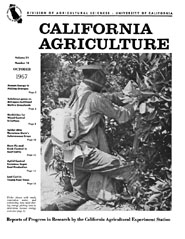


University of California
California Agriculture
|
|||
|
|||

Picker shown with mask, respiration meter, and connecting hose used during orange picking tests to determine human energy costs.
October 1967
Volume 21, Number 10 General Information |
|||
|
University of California, 1301 S. 46th St., Bldg. 478 Richmond, CA
|